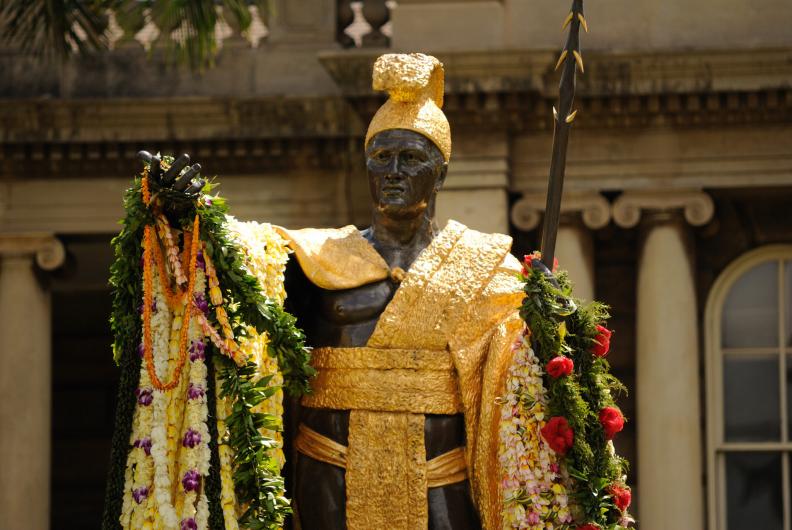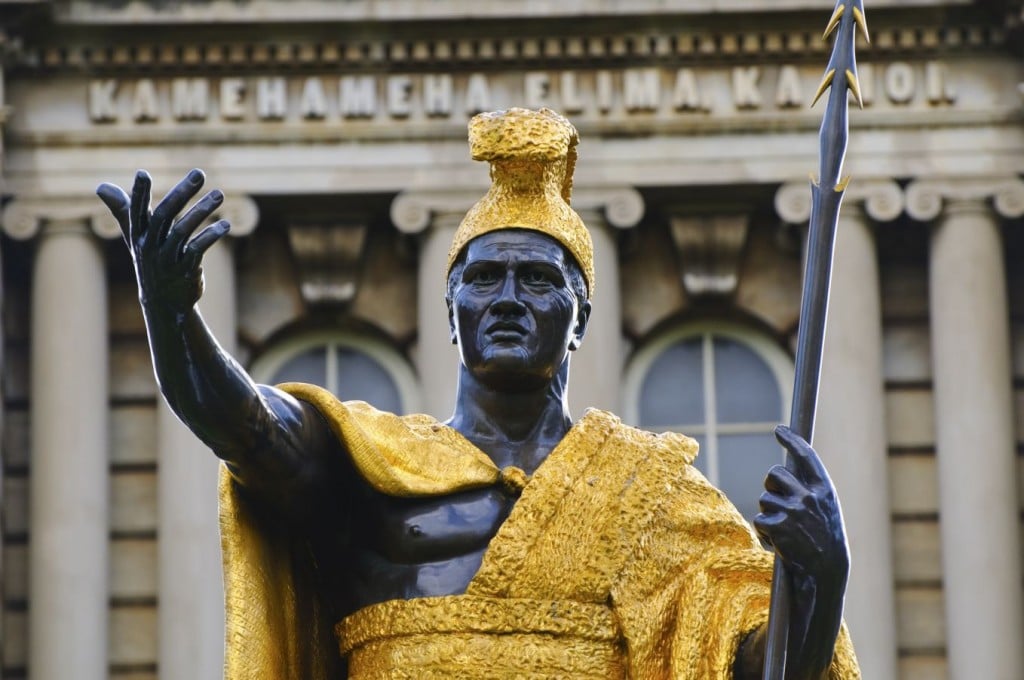5 Fascinating Facts about the King Kamehameha Statues
The stories behind the statues (yes, there are actually more than one) of the king who united all Hawaiʻi.

In Hawaiʻi, June 11 is a state holiday known as King Kamehameha Day, a celebration of the Islands’ most famous historical ruler.
King Kamehameha, also known as Kamehameha the Great, united the Hawaiian Islands in 1810, and according to Walter Murray Gibson, the prime minster of the Kingdom of Hawaiʻi appointed by King Kalākaua who pushed for the famous King Kamehameha monument in Honolulu, set the nation on a path of a “free and enlightened government” that “compared favorably with parliamentary proceedings” of comparable civilizations and governments.
On this day, grand flower lei are draped over this statue, entitled “The Conquerer,” and the four other Kamehameha statues located on Oʻahu, Hawaiʻi Island, Maui and in Washington D.C., including ceremonial parades and cultural observances.
Here are five cool facts about them:
1. The statue at Kamehameha’s birthplace in North Kohala on Hawaiʻi Island is the first one ever made, but was originally supposed to be installed in Honolulu.

The statue located in Kapaʻau was first lost at sea after the ship delivering it to Hawaiʻi wrecked near the Falkland Islands and Cape Horn in 1883. When a second casting was ordered, the statue was eventually recovered by Falkland islanders leaving Hawaiʻi with two statues and brought to Waikīkī aboard a British ship—the rescued/original which one now stands in Kapaʻau, Kamehameha’s Kokoiki birthplace. The re-made replica statue is the one erected in front of Aliʻiōlani Hale in Honolulu, across ʻIolani Palace.
2. The Kamehameha statue at Grand Wailea on Maui is said to be the most accurate representation of Kamehameha the Great.

Compared to the other Kamehameha statues that were made, this version made in 1990 by Hawaiian artist Herb Kawainui Kane is believed to be the most lifelike, incorporating historical documentation and Polynesian features into the sculpture’s facial features. In the late 19th century, the Kamehameha statue currently standing in Honolulu was commissioned by the Kingdom of Hawaiʻi using an American sculptor named Thomas Ridgeway Gould who was living and studying Italian-Roman art at the time in Florence, Italy. He was originally instructed to use a watercolor portrait of Kamehameha by Russian expedition artist Louis Choris as reference. The image is famous for being part of the only known series of portraits of Kamehameha who sat for the artist in 1816, just three years before his death. However, the monument committee, Gibson, specifically, was unhappy with the preliminary rendering and directed Gould to produce a model of Kamehameha at his peak physical stature—Kamehameha as he would have looked at 40 years old. As a result, some of the more European influences surrounding Gould in Italy trickled their way into the final product including in the manifestation of the sandals worn in the statue which in size and scale appeared more Roman in likeness than Hawaiian.
3. The statue’s kāʻei (feather sash) wrapped around Kamehameha’s waist and draped over his left shoulder is a rare type of Hawaiian feather work, by which only three complete examples are known in Hawaiʻi.

The techniques observed to fashion the kāʻei are believed to predate that of the earliest feather cloaks found in Hawaiian collections. It’s suggested that inclusion of the iconographic element commanding the center of the statue worn over a malo (loincloth) is figurative and representational of Kamehameha’s sacred lineage. The kāʻei incorporated into the statue was inherited by Kalākaua in 1877 and according to the Hawaiian National Museum was a sash supposedly inherited by Kamehameha generations after Umi, the ruling aliʻi of Hawaiʻi Island who nearly united all of that island, used it to prove his chiefly status inherited by his father, high chief Liloa, whose line is traced back to the Hawaiian creation myth.
4. The Kamehameha statue at Hilo Bay was intended set to be located on the north shore of Kauaʻi, but was met with opposition.

Because Kamehameha never conquered Kauaʻi (Kaumualiʻi, the king of Kauaʻi, peacefully surrendered to Kamehameha to prevent inevitable invasions of his island), the Princeville Corporation who commissioned the statue for their resort decided to donate it to downtown Hilo, which was a major political hub for Kamehameha.
5. The Kamehameha statue at the U.S. Capitol Visitor Center is molded after the Honolulu statue and the lei that adorn it on Kamehameha Day are flown in from Hawaiʻi.

Nothing replaces the experience of visiting the Oʻahu statue in its royal location, but if you can’t make it to the Islands and are in Washington D.C., a Kamehameha statue was gifted to the National Statuary Hall collection in 1969. It’s currently located in the Emancipation Hall in the Capitol Visitor Center. As it is celebrated across the Islands, on June 11, Kamehameha Day, the mainland statue is draped with lei and flowers and hula performances.


